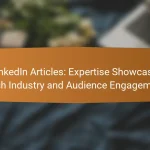Effective follow-up messages are crucial for maintaining engagement after an initial interaction, ideally sent within a few days to demonstrate your interest. These messages should clearly convey their purpose, include relevant details, and feature a call to action to guide the recipient’s response. By fostering relationships through timely and purposeful communication, follow-ups can significantly enhance lead generation and drive conversions, keeping your brand at the forefront of potential customers’ minds.
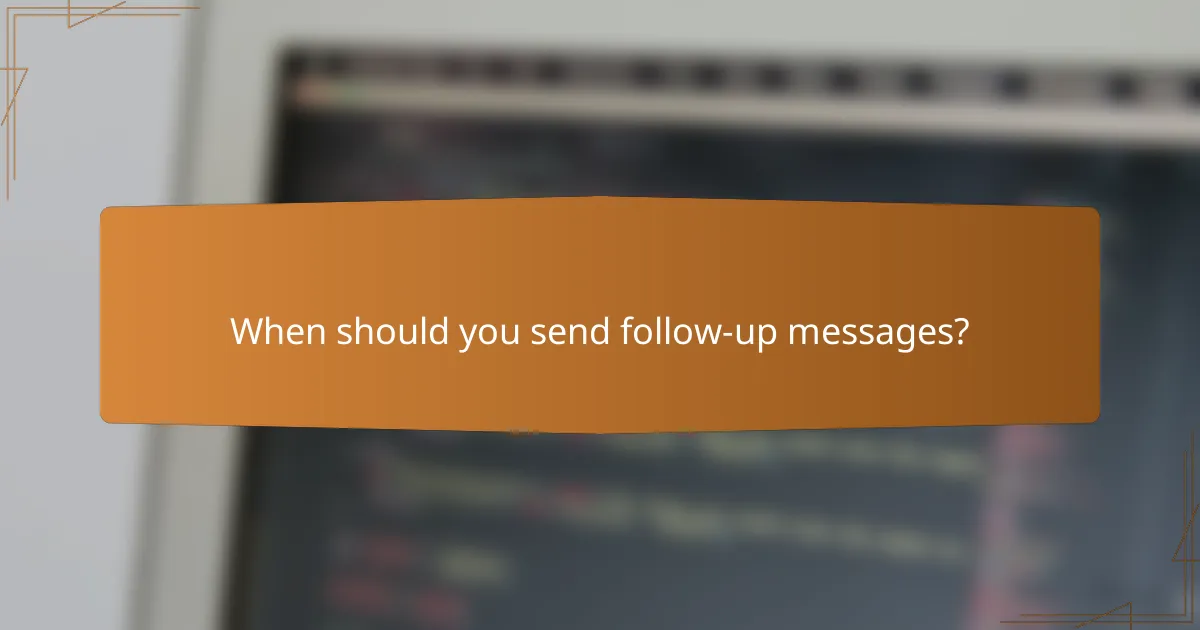
When should you send follow-up messages?
Follow-up messages should be sent promptly after the initial interaction, typically within a few days. This timing helps maintain engagement and shows your interest in the recipient’s response.
Best timing for follow-ups
The optimal time to send follow-up messages is usually within 24 to 72 hours after the initial communication. This timeframe keeps the conversation fresh in the recipient’s mind while allowing them enough time to respond. For job applications, a follow-up after one week is often appropriate.
Avoid sending follow-ups too soon, as this may come off as pushy. Conversely, waiting too long can lead to decreased interest or the recipient forgetting about your previous message.
Factors influencing timing
Additionally, consider the recipient’s schedule and workload. If they are known to be busy, allowing extra time before following up can be beneficial. Understanding the context of your communication will help you determine the best timing.
Industry-specific timing guidelines
For customer service inquiries, responding within a few hours is ideal, while in professional networking, a follow-up within a week is generally acceptable. Tailoring your follow-up timing to industry standards can enhance your chances of a positive response.
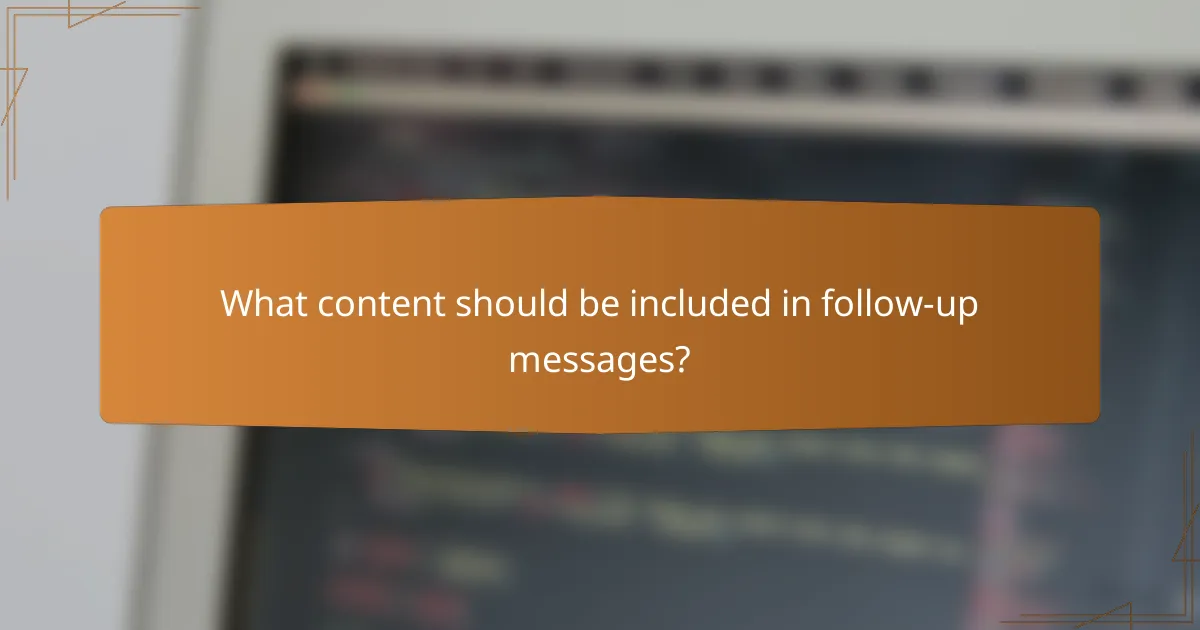
What content should be included in follow-up messages?
Follow-up messages should include a clear purpose, relevant details, and a call to action. This ensures the recipient understands the intent and knows how to respond effectively.
Essential elements of effective follow-ups
Effective follow-ups typically contain a greeting, a reference to the previous interaction, and a concise summary of the main points. Including a specific request or question encourages a timely response.
It’s important to maintain a professional tone while being friendly. Aim for clarity and brevity to respect the recipient’s time, ideally keeping the message to a few short paragraphs.
Personalization techniques
Personalization can significantly enhance the effectiveness of follow-up messages. Use the recipient’s name and reference specific details from your previous conversation to create a connection.
Consider tailoring the message based on the recipient’s preferences or past interactions. This could involve mentioning a relevant topic they expressed interest in or aligning your message with their goals.
Examples of successful follow-up content
A successful follow-up might start with, “Hi [Name], I enjoyed our discussion about [Topic] last week. I wanted to share some additional resources that could help you.” This approach reinforces the previous conversation while providing value.
Another example could be, “Hi [Name], just checking in to see if you had any thoughts on my last email regarding [Specific Request]. I’d love to hear your feedback.” This keeps the dialogue open and encourages a response.
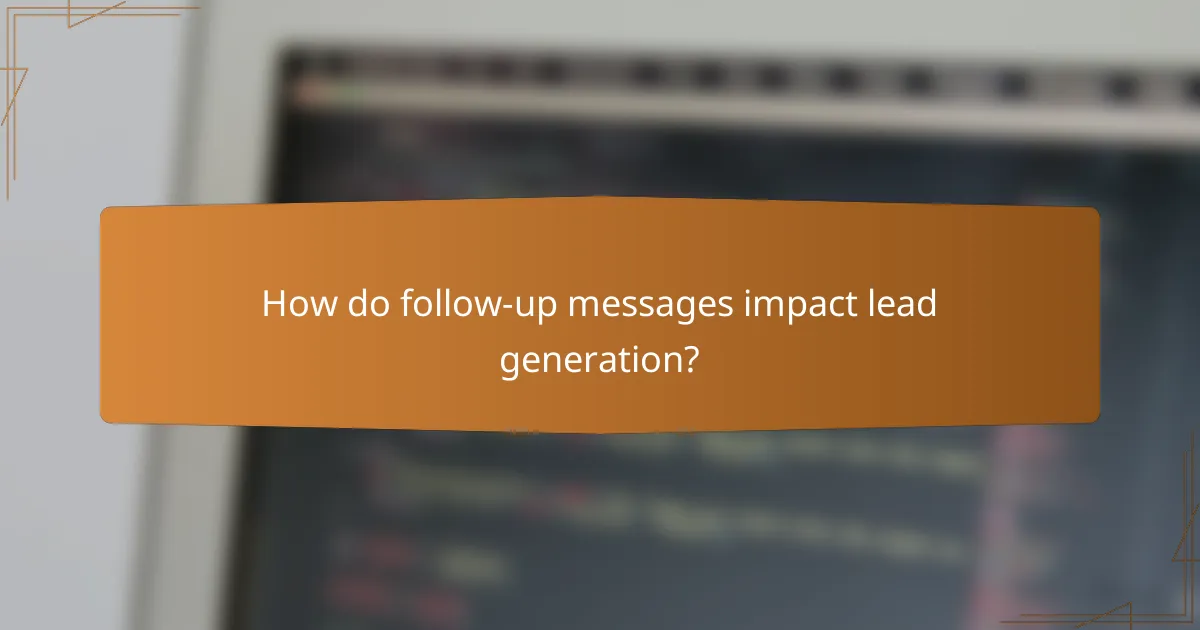
How do follow-up messages impact lead generation?
Follow-up messages significantly enhance lead generation by maintaining engagement and fostering relationships with potential customers. These communications can drive conversions and keep your brand top-of-mind, ultimately leading to increased sales opportunities.
Impact on conversion rates
Follow-up messages can boost conversion rates by reminding leads of your offerings and encouraging them to take action. Studies suggest that timely follow-ups can increase conversion rates by 20-30%, especially when personalized and relevant to the recipient’s interests.
To maximize impact, consider sending follow-ups within 24 hours of initial contact. This timeframe capitalizes on the lead’s interest while your brand is still fresh in their mind. Avoid long delays that can diminish engagement.
Role in nurturing leads
Nurturing leads through follow-up messages involves providing valuable information and addressing potential concerns. This ongoing communication builds trust and positions your brand as a helpful resource, which can lead to higher engagement and loyalty.
Utilize a mix of content types in your follow-ups, such as educational articles, product updates, or exclusive offers. Tailoring these messages based on the lead’s previous interactions can significantly enhance their effectiveness.
Case studies demonstrating effectiveness
Numerous case studies illustrate the effectiveness of follow-up messages in lead generation. For example, a software company found that personalized follow-ups increased their lead conversion rate by 25% over three months, demonstrating the power of targeted communication.
Another case involved a retail brand that implemented a series of follow-up emails after initial inquiries, resulting in a 40% increase in sales from those leads. These examples highlight the tangible benefits of strategic follow-up messaging in various industries.
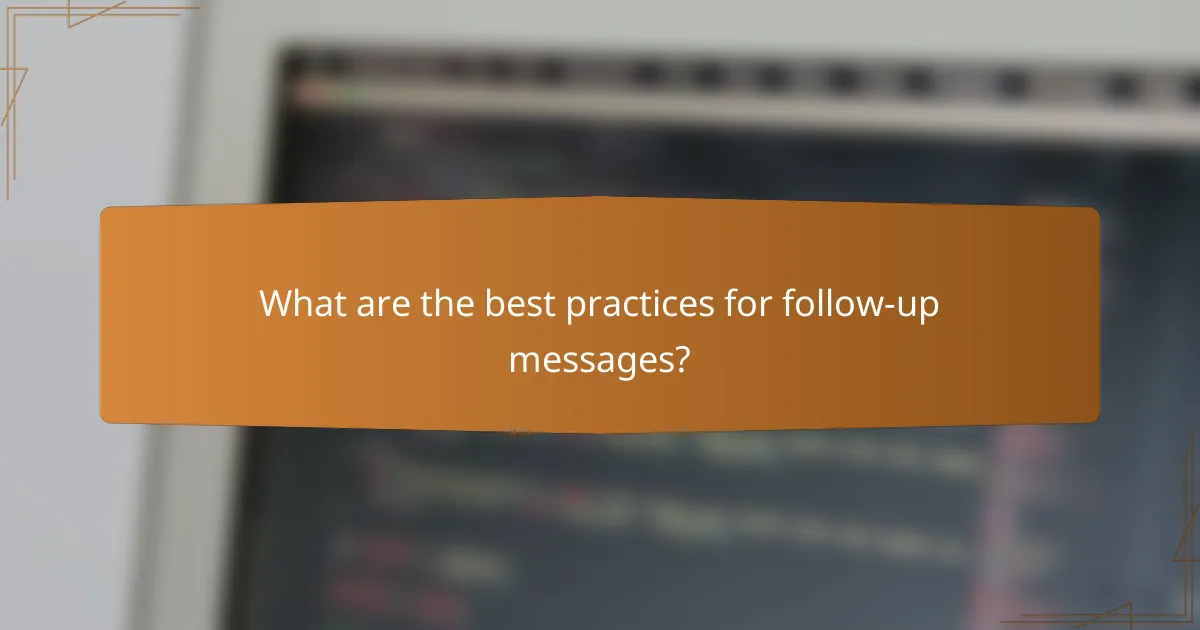
What are the best practices for follow-up messages?
The best practices for follow-up messages include timely delivery, clear content, and a professional tone. These elements ensure your message is effective and increases the likelihood of a positive response.
Structuring your message
A well-structured follow-up message should begin with a brief reminder of the previous interaction, followed by a clear purpose for the follow-up. Use concise language and bullet points if necessary to highlight key information.
For example, start with a greeting, reference the last conversation, and then state your request or update. This format keeps your message organized and easy to read.
Common mistakes to avoid
One common mistake is sending follow-ups too soon or too late. Aim for a window of 3 to 7 days after the initial contact, depending on the context. Following up too quickly can come off as pushy, while waiting too long may lead to being forgotten.
Another pitfall is being vague. Ensure your message is specific about what you are following up on and what you need from the recipient. Avoid generic phrases that do not provide clarity.
Tools for optimizing follow-ups
Utilizing tools like email tracking software can help you determine the best time to send follow-ups based on recipient engagement. These tools often provide insights into when your emails are opened and read.
Additionally, consider using templates for follow-up messages to save time and maintain consistency. Many email platforms offer built-in templates that can be customized for different situations.
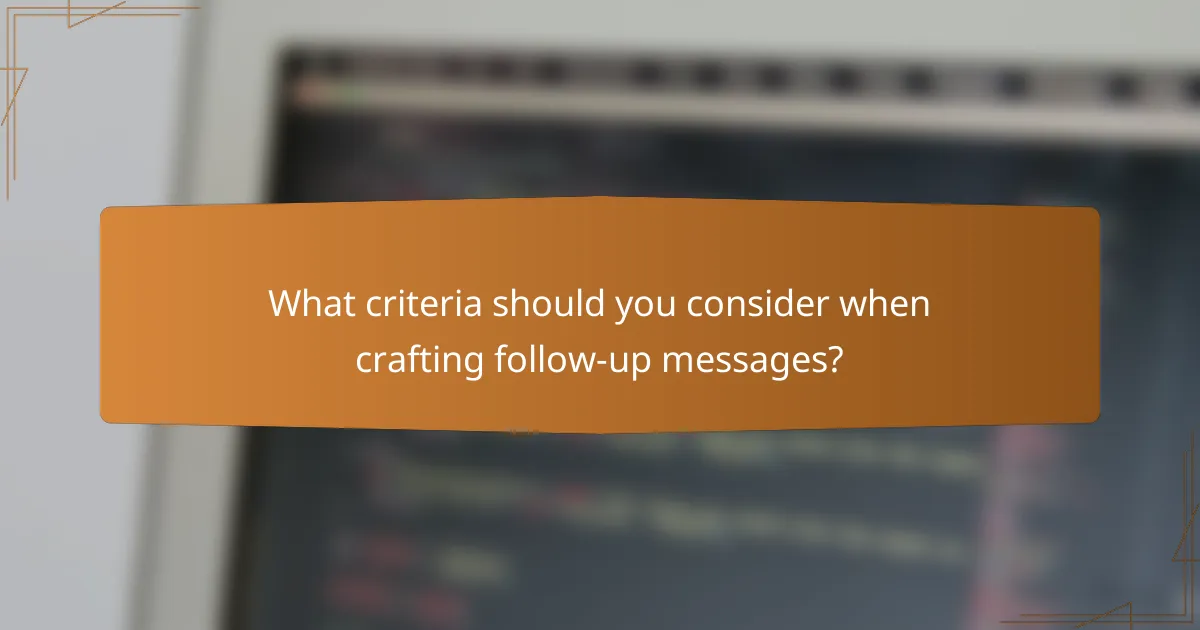
What criteria should you consider when crafting follow-up messages?
When crafting follow-up messages, consider the audience, the tone and style of the message, and the timing of your communication. These factors significantly influence the effectiveness of your outreach and can enhance engagement and response rates.
Audience segmentation
Understanding your audience is crucial for effective follow-up messages. Segment your audience based on demographics, interests, and previous interactions to tailor your communication. For example, a follow-up to a potential client may differ from one sent to a long-term customer.
Utilize data analytics to identify patterns in behavior and preferences. This can help you create targeted messages that resonate with specific groups, increasing the likelihood of a positive response.
Message tone and style
The tone and style of your follow-up message should align with your brand and the relationship you have with the recipient. A friendly, conversational tone may work well for informal contacts, while a more professional tone is appropriate for business communications.
Be mindful of clarity and conciseness. Use straightforward language and avoid jargon unless you are certain the recipient will understand it. A well-structured message with a clear call to action can significantly improve engagement.
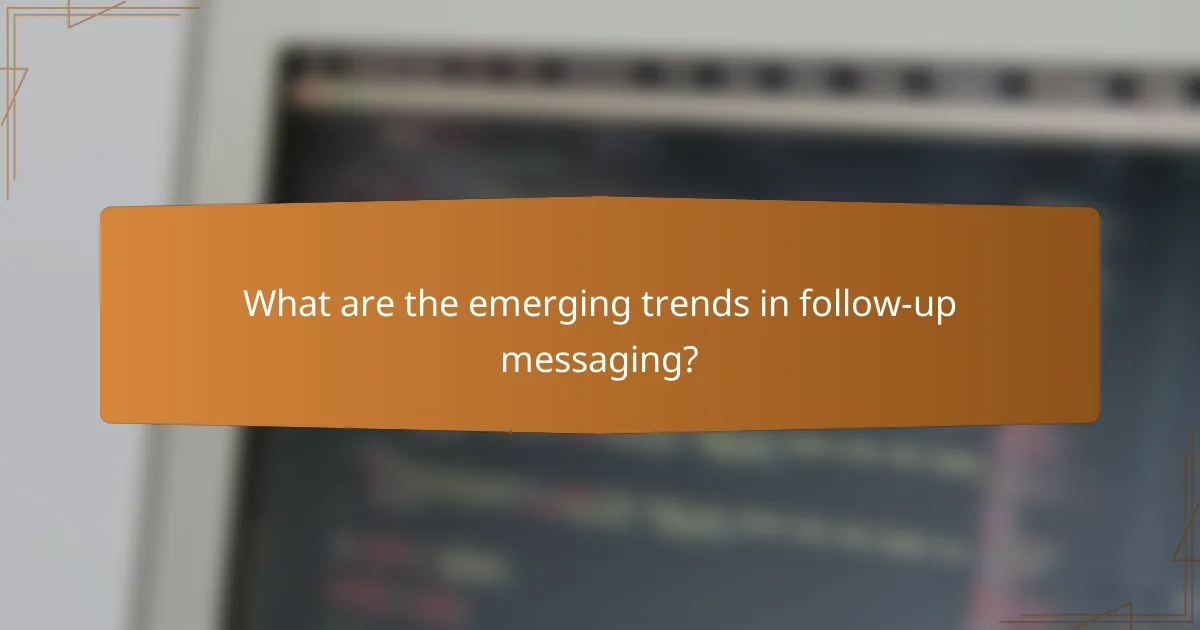
What are the emerging trends in follow-up messaging?
Emerging trends in follow-up messaging focus on personalization, automation, and timing to enhance engagement and effectiveness. Businesses are increasingly leveraging technology to streamline their follow-up processes while ensuring that messages resonate with recipients.
Automation in follow-ups
Automation in follow-up messaging allows businesses to send timely and relevant communications without manual intervention. This can include automated emails, text messages, or notifications triggered by specific actions, such as a purchase or a website visit.
When implementing automation, it’s essential to segment your audience based on behavior and preferences. For instance, a customer who abandoned their shopping cart might receive a tailored reminder, while a recent buyer could get a thank-you message with product recommendations.
However, while automation increases efficiency, it’s crucial to maintain a personal touch. Avoid overly generic messages; instead, use dynamic content to personalize each communication. Regularly review and adjust your automated workflows to ensure they remain effective and relevant to your audience’s needs.

